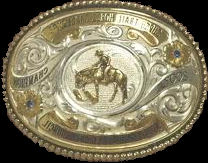Extreme Horsemanship Obstacle Challenges combine horsemanship skills, obstacle navigation and the element of speed.
Events are held in an outdoor arena or open field course with marked boundaries.
Each event is comprised of 10 - 13 obstacles and will have a time limit of no more than 8 minutes.
Obstacles will be scored on a scale of 1 – 10 with 1 being the lowest and 10 being the highest. Scoring of obstacles will be in quarter point increments (awards or deductions) based on performance. Obstacle navigation is divided in to 3 parts for judging, with one over-all score given for each obstacle: approach (2 points), obstacle (6 points) & exit (2 points). An average score for an obstacle is 5.5 - 6.
will be in quarter point increments (awards or deductions) based on performance. Obstacle navigation is divided in to 3 parts for judging, with one over-all score given for each obstacle: approach (2 points), obstacle (6 points) & exit (2 points). An average score for an obstacle is 5.5 - 6.
An over-all horsemanship score of 1 – 10 with 1 being the lowest and 10 being the highest will be awarded to each rider.
Speed Bonus Points will be awarded in the following manner
Time Finished



 Points Received
Points Received
all others finishing within alotted time  + 5
+ 5
Penalties (-1/4) point per incident
· Incorrect lead
· Gaping mouth
· Incorrect speed transition (transitioning from gallop to walk or stop, from trot to stop)
Incorrect speed transition (transitioning from gallop to walk or stop, from trot to stop)
· Excessive spurring
Excessive spurring
· Hanging or balancing on the reins to maintain balance
· Going too fast when conditions make the footing unstable
· Being heavy handed
· Having excessive speed going into an obstacle
· Exaggerated cues
Exaggerated cues
· Spook (obvious shy from part of course or obstacle)
· Refusal
Refusal
· Rushing part of obstacle
Rushing part of obstacle
Awards (+1/4) point per incident
· Picking up and maintaining the correct lead
· Riding on a loose rein
·  Subtle cues
Subtle cues
· Keeping horses’ hind inside leg planted during a turn around
· On a turn around, showing speed and crossing over in front without hopping
· Smooth stop, without pulling on the horses’ face, causing gaping mouth and head elevation
· Proper speed transition with good control
· Keeping the horse collected and correct throughout the obstacle maintaining proper framed body
·  Mounting smoothly without excessive pulling on wither, reins or landing with excessive, unbalanced force in saddle
Mounting smoothly without excessive pulling on wither, reins or landing with excessive, unbalanced force in saddle
·  Dismount smothly without excessive pulling on wither or excessive pressure on reins
Dismount smothly without excessive pulling on wither or excessive pressure on reins
·  Lead without excessive pressure or weight on reins
Lead without excessive pressure or weight on reins
·  Controlled stop and stand
Controlled stop and stand
THE APPROACH (2 Point value)
Every rider will start the approach with a score of 0, and receive quarter point increments or deductions, based on performance.
The approach to any obstacle might involve a downward transition to a trot or walk from a canter or even a gallop. An emphasis is put riding with a loose rein. Scoring is based on lightness, subtle cues and willingness of the horse to make the speed transition while examining the obstacle and anticipating cues from the rider.
The downward speed transition should be smooth, soft and balanced. The horse should be in a natural frame and willingly respond to cues from the rider. The horse should not act as if being pulled down by strength or resisting contact.
The approach should be as straight as possible.
THE OBSTACLE (6 point value)
After transitioning down to a safe speed the horse should maneuver the obstacle without fear or hesitation and be looking to find their way through the obstacle. Judges are looking for a horse working on a loose rein, responding to subtle cues and commands. The horse should be moving forward with confidence.
Horse and rider should be working as a team, with the rider aware of horse's feet placement, speed rating. The horse shoul willing and relaxed, focused on the obstacle and rider cues.
THE DEPARTURE (2 point value)
Exiting the obstacle should be smooth (after a completed obstacle) with a responsive, yet controlled upward speed transition, and a direct and purposeful line being established to the next obstacle. Picking up the correct leads are important here but only in so much as to be acquired when the speed dictates. A lot of riders may exit at a trot, then acquire the new lead on the way to the next obstacle.
The Exit from an obstacle should set the tone for the approach to the next obstacle, establishing balance, speed rating and communication between horse and rider.





